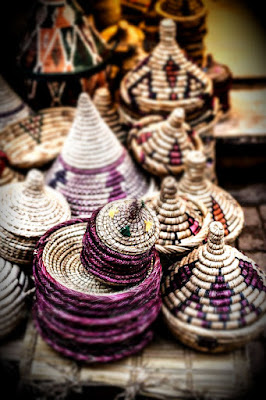Cooking Moroccan: Unique Moroccan Cookware
Cooking Moroccan: Unique Moroccan Cookware
After another
laborious week, I’m back and I’d like to show something interesting and
entertaining for all of you interested in Moroccan cooking tools, devices and
further cookware.
Let me also tell
you that I did not see all this being used at the households I’ve visited
throughout Morocco, but I’m sure there are many families using many or even all
of them. I will also make a remark for those tools which I feel would be good
if you got on the long haul, but for the start, you will be just fine without
all these. It’s rather for the inspiration and the information than for practical
use as of now.
Let’s get
started!
Tagine
The traditional
Tagine made out of clay is a great cookware and it’s also the trademark
cookware of everything Moroccan. It’s widely used both for slow cooking dishes
and also for serving dishes. It’s a typical example of a dish being named after
the cookware it’s being cooked it. Tagine is great for cooking any saucy meaty
food and there are hundreds of variations for tagine dishes. Spoiler alert:
every single one of them tastes excellent!
Tagines can only be used for cooking on a normal stove if your kitchen
is armed with a special diffuser that’s used for slow cooking.
Recommended:
rather for serving as it requires very specific methods for slow cooking in
order for it not to get ruptures. Tagines are sold in an extreme wide variety
ranging from the smallest to the largest ones, also you can buy plain
undecorated ones more for cooking reasons and the highly decorated ones which
are more for serving or simply as souvenirs. Tagine today is very trendy to be
featured in Western kitchens too and it’s definitely a great souvenir to take
home.
Gsaa:
 |
| Gsaa |
This is perhaps
the most commonly used cookware I have seen all around Morocco. This extra-large
plate is traditionally for the serving of the Friday Couscous but the
housewives of Morocco are also using it alternatively for the making of all
sorts of pastries or dough, typically those you cook at home, such as Msemen, Beghrir and the Meloui which this way are
ready to be fried in a few minutes’ time. I’ve only seen clay Gsaa but it’s
been said that the best ones are those made out of wood.
Recommended: Definitely recommended, if I go to Morocco
next time, I will definitely try to get one for my kitchen because not only
they look very characteristic they are extremely useful too.
Majmar:
 |
| The traditional Majmar |
This very unique looking cookware is traditionally
used as a slow cooker specifically for tagines. The burning charcoal is put
into the Majmar which from then on will serve as a sort of as stove for it.
This is something I do not see in modern Moroccan households and haven’t seen
anyone cooking with it, but it certainly looks great and I’m sure it’s still
used in the villages and the desert areas.
Recommended: Not really unless you are absolutely crazy for folk arts. Majmars are heavy and hard to carry anywhere.
Tangia:
I have already
spoiled this as I couldn’t refrain myself talking about it in the previous
part. Please go and check it out by clicking here.
Tbeq:
This is another
typical cookware which has to be part of most Moroccan households and the best
part of it is that with the proper tools it’s very easy to keep clean and it’s
lightweight. Typically handwoven Tbeq is used for hand rolling couscous.
Alternatively it’s also used for holding any sort of dishes and can also serves
as a pad.
Recommended: Tbeq serves as a great, colorful souvenir which is easy to carry but it can still add a nice touch to any kitchen. It is made in lots of color combinations although those keeping the original color are the ones originally used for making couscous.
Couscoussier:
 |
| Couscoussier developing with the age |
No Moroccan household
is missing a real couscoussier which is either a double or a triple layered cooking device which
is a proper steamer that’s used to steam couscous 3 times in order for it to gain its best shape, form
and color ( see more on how to steam couscous in my previous article). Mind you, the preparation of real couscous is a long, time-consuming process and mostly this is the activity dedicated for Friday mornings, as couscous is traditinally consumed after the Friday Dhurhr ( Midday prayer).
Recommended: I wouldn't particularly recommend you buy a couscoussier just now. I haven’t seen couscoussier anywhere in the West but I’m sure
you can buy it on Amazon. But only buy it if you are serious about making
couscous which normally takes a long experimenting to do.
Until then you can
try and start with a standard steamer.
Tbiqua:
 |
| Tbiquas come in every color combination possible |
You can get to
buy Tbiqua in many shape and form all around Morocco where they are typically
selling them at souks. This is generally used as a bread holder, but they store
other things in it too.
Recommended: I would certainly recommend you to get some of this for souvenir. Apart from being light-weight, its colors certainly add up to the style of any kitchen or room. Plus they are pretty practical too!
I hope you liked
this part of Cooking Moroccan series and please follow my blog for more
updates. My initial plan is to start cooking with you guys and give you
inspiration to carry on and do Moroccan dishes by yourselves as it’s well worth
it. Ask me, comment or share your experiences with me.




Comments
Post a Comment